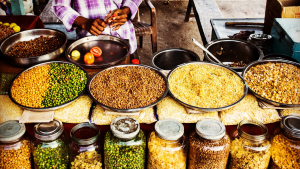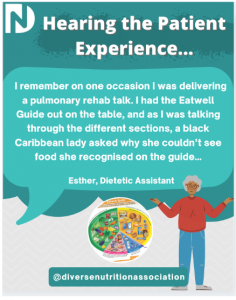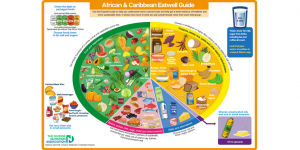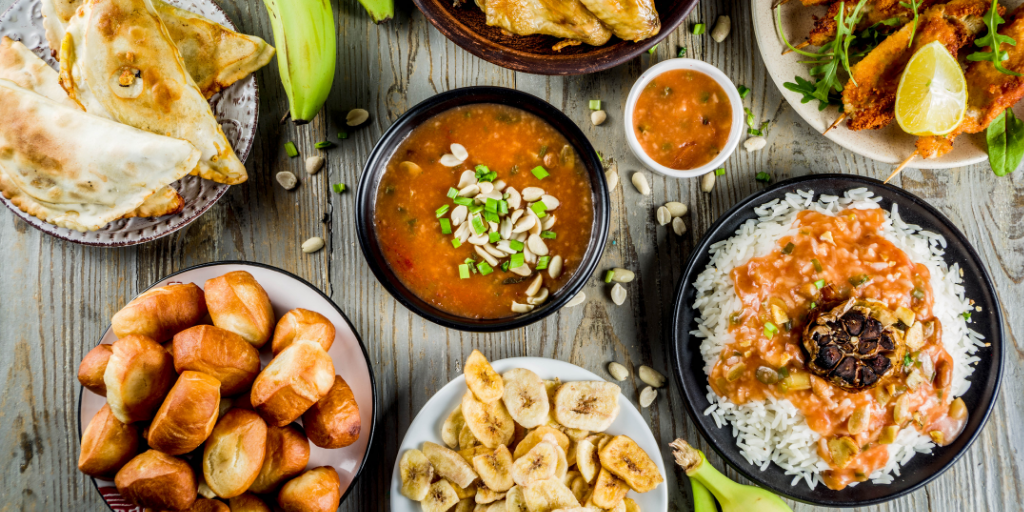 Guest author: Melissa Saint Hill, Registered Nutritionist (RNutr) & Clinical Project Manager. Melissa is a Clinical Project Manager in the pharmaceutical sector with a focus on patient engagement, recruitment and retention. She is also a co-founder of The Diverse Nutrition Association and a Registered Associate Nutritionist (ANutr) with a Masters in Nutritional Sciences and a Masters in Clinical Research of Human Nutrition. Melissa is passionate about working to support and educate healthcare professionals and members of the community with respect to culturally inclusive healthy diets.
Guest author: Melissa Saint Hill, Registered Nutritionist (RNutr) & Clinical Project Manager. Melissa is a Clinical Project Manager in the pharmaceutical sector with a focus on patient engagement, recruitment and retention. She is also a co-founder of The Diverse Nutrition Association and a Registered Associate Nutritionist (ANutr) with a Masters in Nutritional Sciences and a Masters in Clinical Research of Human Nutrition. Melissa is passionate about working to support and educate healthcare professionals and members of the community with respect to culturally inclusive healthy diets.
THE AFRICAN AND CARIBBEAN EATWELL GUIDE
In contrast to other ethnicities in the UK, Black African and Caribbean populations are at a higher risk of experiencing hypertension, heart disease and stroke. Whilst further implementation of ethnic monitoring data is required to understand why these risks are heightened in Black African and Caribbean individuals in the UK, what we do know is that modifications to lifestyle may help to reduce risk. The Black UK population are encouraged to consume more fruits and vegetables, and work to reduce diets high in sugar, salt and fat, as well as increase physical activity.
Current visual healthy eating guidelines via the Eatwell Guide can be a good general starting point to somewhat give an overview to this advice. But how visually representative or helpful is it when taking a look at some of the frequently consumed foods of Black Africans and Caribbeans within the UK? Does the current Eatwell Guide cater to increased population diversity? Do the majority of people know where the wealth of foods consumed across these Black cultures fit into the current Eatwell Guide?
An Increasingly Diverse Britain & Health Equity
According to the 2011 Census records, the Black/African/Caribbean/Black British population comprises the second largest ethnic minority group within the UK, accounting for 3% of people within the UK, and 13.3% within London. As the population continues to become increasingly ethnically diverse, with people coming from a multitude of countries bringing their culture and customs with them, public health messages and resources must exist to resonate with a wider audience.
Countries that experience increased population diversity do not tend to have adequate access to services for certain ethnic groups, thus currently falling short where health equity is concerned. We need to ensure that health-related resources can be easily accessed, and that they are both culturally relevant and sensitive. In order for health messages to be effective, beliefs and attitudes need to be considered at a cultural level. People need to be able to see what they can identify with, at least in part, in order to improve behaviour and attitudes to healthy eating and lifestyle advice and make it work for them based on their cultural norms and identity, and their own individual local realities.
The Need for an African and Caribbean Guide
As associate registered/registered nutritionists, myself and my two co-founding colleagues at The Diverse Nutrition Association have all worked with UK African and Caribbean communities across our different specialisms; whether that be via 1-2-1 consultations or group workshops, church initiatives, schools, clinical research or public health intervention programmes. When using current healthy eating tools, the overarching theme communicated within the Black community was the assumption that because their foods were not shown in resources, that they must not be healthy or important.
As with anything, it was therefore important to take our valuable insights of community feedback gained over the past few years and pair it with data and evidence before developing any resources. We felt that this would best illustrate what people felt and were saying, as we realised that our experiences within the community were not isolated to our own experiences.
During the last few months of 2020, we worked to develop an online survey which consisted of qualitative questions using Likert scales and qualitative questions that would allow people to really express their views in their own words. The survey was then distributed to networks of people within Black African and Communities across the UK. A total of 95 people aged 18 to 68 completed the survey, which allowed us to analyse how often cultural foods were consumed and exactly what popular foods were consumed amongst these responders.
The key findings from the survey matched people’s frustrations offline that we repeatedly heard throughout our own individual work-streams within the community. It was felt that there was indeed a lack of visual representation where UK nutrition and health resources were concerned, as expressed by 71.5% of responders. With that, we saw 66.6% of responders reporting that they consumed some of their cultural foods at least weekly, and a total of 95.8% of respondents reporting that they would find having an Eatwell Guide that had an overall focus on African and Caribbean foods to be useful with helping them make long term healthy dietary choices.
Some of the sentiments that people expressed were as follows:
“I believe the Eatwell guide is a general summarisation of what is considered healthy for European standards”
“Healthcare professionals don’t tend to know much about African foods”
“Just because our food is cultural, doesn’t mean it isn’t healthy”
“A guide for healthy eating geared towards black ethnic foods would be good for white parents of mixed-race children who are interested in cultural food but may not necessarily have cultural knowledge”
“If there were guidelines specific to different cultural foods, this would be beneficial”

Fig 1: A quote from a member of the Caribbean community, serving as a typical example of what we heard as healthcare practitioners across Black African and Caribbean communities when showing tools and resources to aid with the encouragement of healthy eating communications.
DEVELOPING THE AFRICAN AND CARIBBEAN EATWELL GUIDE
To meet the needs evident in our research, we developed the bespoke African and Caribbean Eatwell Guide and made it available to download from the Diverse Nutrition Association Website
Culinary acculturation across both African and Caribbean communities to the UK diet across is evident; this was considered as our guide was being developed, which is why we did not remove anything from the existing guide. The frequently reported foods from survey responders helped with shaping our content, as shown below:
CARBOHYDRATES
Sweet potato: Eaten boiled or roasted and often in stews. Also used to make puddings

Cassava: Used to make popular Jamaican flatbreads such as bammy, or pounded to make west African dishes such as fufu, garri or kenkey
Yam: Pounded in West African cuisines, used in soups and stews. Can also be used to make fufu
Breadfruit: Often roasted and served with dishes such as ackee and saltfish. Savoury, although riper varieties have a subtle sweet taste
Taro root: Staple often used in stews
Plantain: Green plantains are starchy, whilst yellow plantains are sweeter. Frequently used in soups, stews, curries or as a standalone side dish. Used in a variety of ways across Caribbean and African cultures (e.g. tostones and tatales)
Green banana: Typically boiled and served with other sides such as yam. Can be used in soups or salads also
Hardo bread, roti, injera: Can all be requested as wholegrain versions in African/Caribbean ethnic supermarkets
Barley, fonio, spelt, kamut, teff: Commonly consumed grains

PROTEINS
Lentils: Used in salads and stews
Chickpeas: Used in curries, stews, or to stuff flatbreads such as Trinidadian doubles
Snapper: Often grilled or stewed
Mackerel: Popular in Jamaican coconut-based dish such called mackerel rundown, typically made with yam and green banana
Tilapia: Popular fish across many African countries
Soy chunks: Typically used in a lot of plant-based meals
Egusi: Melon seeds. Can be used in soups or stews
Beans: Kidney and black beans shown here but a variety of beans such as gungo peas, or black eye peas used in dishes such as rice and peas, Caribbean stews (stew peas) West African stews (red red or groundnut stew)
FRUITS & VEGETABLES
Coconut: Used in a variety of dishes from stews, breads (coco bread), curries
Pineapple: Popular fruit sometimes used in savoury dishes such as salsas
Jackfruit: Typically eaten just as a fruit, not used in cooking traditionally
Watermelon: Popular fruit across both cultures, especially with it growing in Jamaica and being available year-round
Ackee: Sold in tins in the UK – yellow fleshy fruit eaten. Used in many savoury dishes such as ackee and saltfish or in stew or curries
Sapote: Species of persimmon, also known as ‘chocolate pudding fruit’
Guava: Popular fruit. Sometimes used in jellies, jams or glazes for bbqs
Pak choi: Popularly consumed, particularly in Caribbean cuisine
Cho cho: Typically used in soups and stews
Tamarind: Popular snack and used in savoury cooking also
Soursop: Often made into beverages
Scotch bonnet: Spicy chilli with sweet undertones, added to many African and Caribbean dishes
Pumpkin: Often eaten steamed, added to curries or rice dishes (seasoned rice or pilaf)
DAIRY ALTERNATIVES
Soya and almond milk: Alternatives for plant-based or Rastafarian (vegan) communities
FOODS HIGH IN SALT, SUGARS AND FATS
Patties or pies: Popular buttery, flaky doughs filled with meats, fish or vegetables
Malt beverages: Tend to be high in sugar
Condensed milk: Often used in breakfast cornmeal porridge or carrot punch. Popularly used in desserts also
Fried doughs: Fried dumplings consumed as part of ‘fry-up’ breakfasts with ackee and saltfish, or as a side with dinner. Can be stuffed with meat or vegetables. Sweet and savoury versions
Using the guide
The African and Caribbean Eatwell Guide will support healthcare professions in learning about some popular foods that represent countries that shape African and Caribbean communities within the UK. The first thing is to remember that the food groups remain exactly the same. A carbohydrate is still a carbohydrate, a protein is still a protein and so on. Categorising the foods into groups takes on the same sentiment.
Even if you aren’t aware of some of the foods within the guide (and this is why we have labelled some of the more unfamiliar items), you can use the guide to encourage discussion. As we have seen within community engagement work, people will identify with some of the foods they eat here, and this will be more than enough to open up further discussion. You will see a transition from people not engaging very much to being much more conversational – and during those fact finding moments, you will gain even more valuable information, which not only helps to increase your cultural humility and understanding of different cultures and behaviours that impact health, but you will become more comfortable and open.
Your patient or client will pick up on this and it tends to be very well received. The most important benefit is that they leave with realistic and appropriate measures and recommendations – likely leading to better health outcomes. Of course, not all foods will be on here, but by using the guide, you will start to get a better understanding of different foods and where they may fit.
After successfully presenting our survey data and evidence to Public Health England in January 2021 and seeing a demand via download of our African and Caribbean Eatwell guide since October 2021, we encourage Public Health England to consider official publication of this very useful resource as it helps both healthcare practitioners and people with the community.
RELATED MYNUTRIWEB CONTENT
African and Caribbean Eatwell Guide – 60 mins webinar with Melissa Saint Hill and Amaeze Madukah and supporting Resource Blog
South Asian Eatwell guide (2021). 60 mins webinar with Fareeha Jay RD discussing the importance of culturally competent advice and the use of her new South Asian Eatwell Guide
South Asian Eatwell Guide (2021). Blog post by Fareeha Jay around the new Eatwell Guide where you can download the PDF of the South Asian Eatwell Guide
Sugar Awareness in the South Asian Diet (2021). Blog post by Fareeha Jay with practical advice for sugar within the South Asian diet
Ramadan: Top Tips for Eating Well (2021). Shehnaz Bashir RD. Blog post with practical tips for how to eat well during Ramadan
If you would like a full list of the references, please contact us.
Let us know what you think of the blog and share your thoughts in the comments box below.







I find the EatWell GUide for Black African/Caribbean very useful. As a Health and Wellbeing Coach with interest in diabetes and Obesity,this guide will serve as as a useful resource materials for my patients. I am also a research with interest in diatary habits of Black African children- please can you share your survey link and research with me. Thanks
Hi there Joshua, thank you for your feedback and we’re glad that you have found our resource to be useful! If you email us directly at info@diversenutritionassociation.com then we can share further information with you. Thanks
– The Diverse Nutrition Association
Thanks for the response.
Email has been sent out to your named address for future correspondence
I am sorry, unfortunately I am yet to receive the email request for the survey questionnaire for The Africa and Caribbean Eatwell guide
Thanks
I find the Eatwell Guide for Africa and Caribbean very useful and a game changer for my patients who are mostly from the African and Caribbean community .
I will appreciate it if you can share the full reference and the survey questionnaire including participant feedback with myself
Many thanks
I have been asking around for a resource like this for over a decade now, so I am quite pleased that it is available. It is a very helpful resource that and I have sent the link to several of my what ap groups. keep up the good work
This is refreshing to see! Lots of my clients are from an African / Caribbean heritage, so this will be a useful tool to share in clinical practice.